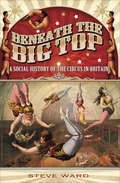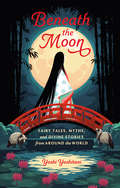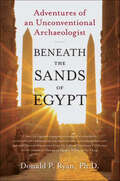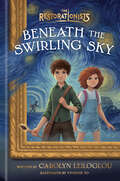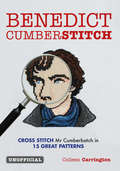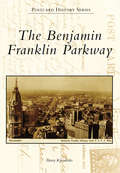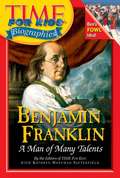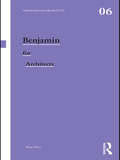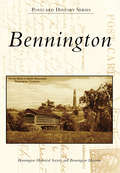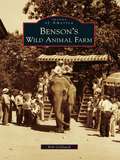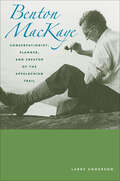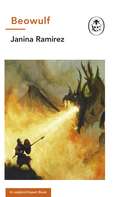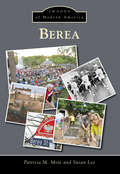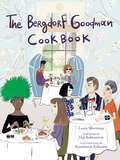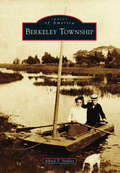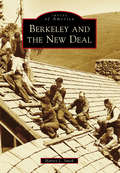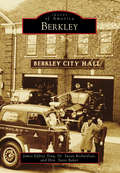- Table View
- List View
Beneath the Big Top: A Social History of the Circus in Britain
by Steve Ward&“A valuable and illuminating read, shedding a lot of light on the political, economic and technological factors that have driven circus evolution&” (The Circus Diaries). Beneath the Big Top is a social history of the circus, from its ancient roots to the rise of the &“modern&” tented travelling shows. A performer and founder of a circus group, Steve Ward draws on eyewitness accounts and contemporary interviews to explore the triumphs and disasters of the circus world. He reveals the stories beneath the big top during the golden age of the circus and the lives of circus folk, which were equally colorful outside the ring: • Pablo Fanque, Britain&’s first black circus proprietor • The Chipperfield dynasty, who started out in 1684 on the frozen Thames • Katie Sandwina, world&’s strongest woman and part-time crime-fighter • The Sylvain brothers, who fell in love with the same woman in the ring &“As a former circus performer and now teacher and circus professional I thoroughly enjoyed this book!! The Circus has such a rich history and Steve does an amazing job at not only chronicling it but also telling entertaining and wonderful stories throughout. The photos are also amazing!! I recommend this book for both circus professionals and also for everyone else . . . it is a fabulous read for all!!&” —Carrie Heller, Circus Arts Institute (Atlanta, GA)
Beneath the Moon: Fairy Tales, Myths, and Divine Stories from Around the World
by Yoshi YoshitaniPowerful and universal retellings of seventy-eight divine stories, legends, and myths from around the world, each accompanied by a gorgeous illustration from acclaimed artist Yoshi Yoshitani.Many of the lessons we learn are shared stories passed among cultures and generations. In this riveting collection of fables and folktales from cultures across the globe, characters from beloved fairytales, cultural fables, ancient mythologies, and inspirational deities are brought to life, including Sleeping Beauty (Italy), Rapunzel (Germany), Jack and the Beanstalk (England), Our Lady of Guadalupe (Mexico), Sun God Ra (Egypt), the Crane Wife (Japan), and dozens more. Lesser-known stories introduce characters such as the volcano goddess Pele from Hawaii; Mwindo, the wise and powerful king of the Nyanga people; and the strong and resilient Yennenga, mother of the Mossi people in Burkina Faso. The recurring themes of conquering evil, overcoming adversity, and finding love and companionship are woven throughout this collection.Yoshi Yoshitani's art style is fresh and unique, featuring diverse and multicultural characters. Each story will be featured opposite a correlating illustration, both lush and vibrant.
Beneath the Sands of Egypt: Adventures of an Unconventional Archaeologist
by Donald P. Ryan“Donald Ryan is a rare bird—a field archaeologist who can write with verve and immediacy. I heartily recommend his book to all Egyptology buffs.”—Barbara Mertz ( a.k.a. Elizabeth Peters), author of Temples, Tombs, and HieroglyphsA real-life “Indiana Jones,” Donald P. Ryan, Ph.D., offers a breathtaking personal account of his adventures in archaeology in Beneath the Sands of Egypt. Fans of The Lost City of Z will thrill to the exploits of this “unconventional archaeologist” as he retrieves the remains of Egypt’s past—including his breakthrough discovery in the Valley of the Kings of Egypt’s famous female pharaoh, Hatshepsut.
Beneath the Swirling Sky (The Restorationists #1)
by Carolyn LeiloglouA house full of paintings, a missing sister, and a family secret send a boy and his cousin into a world where art is the key in this fantasy adventure perfect for fans of The Wingfeather Saga and Pages & Co.&“A delightful adventure, excellent for reading aloud. This book will make you want to study Van Gogh and get out the paintbrushes!&”—Sarah Mackenzie, founder and host of Read-Aloud Revival® and author of The Read-Aloud FamilyAfter an experience he&’d rather forget, Vincent is determined to be done with art. So when he and his little sister, Lili, spend spring break with their art conservator great-uncle, Vincent&’s plan is to stay glued to his phone.That is, until Lili disappears into one of the world&’s most famous paintings and Vincent learns his parents have been hiding something from him: Their family is the last of The Restorationists, a secret society with the power to travel through paintings—and a duty to protect them from evil forces.With Lili&’s safety on the line, leaving art behind is no longer an option. Vincent must team up with his know-it-all second-cousin Georgia, wrestle with why his parents lied to him, and confront both his past and a future he never wanted. Young readers are invited into a captivating universe where paintings become a portal—and adventure and danger lurk beyond every canvas.
Benedict Cumberstitch: Crossstitch Mr Cumberbatch In 15 Great Patterns
by Angela WrightYou've watched all his films, you've coloured him in, and, let's face it, you've tried out how your signature would look with 'Cumberbatch' at the end of it - now it's time to get stitching! Benedict Cumberstitch is your unofficial guide to creating a series of amazing cross stitch designs featuring the Cumberbatch in all his glory. Beginners can quickly pick up the simple yet addictive art of cross stitch, and seasoned stitchers will be delighted by the range of designs on offer. Whether you want to see him smouldering in a tuxedo, delivering a soliloquy as Hamlet, or photobombing with the best of them, there's sure to be patterns here to satisfy even the most dedicated of Cumberbitches.
Benedict Cumberstitch: Crossstitch Mr Cumberbatch in 15 great patterns
by Angela WrightYou've watched all his films, you've coloured him in, and, let's face it, you've tried out how your signature would look with 'Cumberbatch' at the end of it - now it's time to get stitching! Benedict Cumberstitch is your unofficial guide to creating a series of amazing cross stitch designs featuring the Cumberbatch in all his glory. Beginners can quickly pick up the simple yet addictive art of cross stitch, and seasoned stitchers will be delighted by the range of designs on offer. Whether you want to see him smouldering in a tuxedo, delivering a soliloquy as Hamlet, or photobombing with the best of them, there's sure to be patterns here to satisfy even the most dedicated of Cumberbitches.
Benjamin Franklin Parkway, The
by Harry KyriakodisThe Benjamin Franklin Parkway has sliced through the Logan Square neighborhood of Center City (downtown) Philadelphia since World War I. Named after Philadelphia's favorite son, the mile-long boulevard begins at city hall and heads diagonally towards Logan Circle before reaching the Philadelphia Museum of Art. The postcards and other images in this work show the parkway's development and its role in Philadelphia's civic and cultural life. Despite often serving as a speedway into and out of town, the Ben Franklin Parkway is a triumph in urban planning that has become a treasured part of the City of Brotherly Love.
Benjamin Franklin: A Man of Many Talents
by Editors of TIME FOR KIDS Kathryn Hoffman SatterfieldA brief biography highlights some of the achievements of one of the most famous men from the early years of the United States.
Benjamin for Architects (Thinkers for Architects)
by Brian ElliottWalter Benjamin has become a decisive reference point for a whole range of critical disciplines, as he constructed a unique and provocative synthesis of aesthetics, politics and philosophy. Examining Benjamin’s contributions to cultural criticism in relation to the works of Max Ernst, Adolf Loos, Le Corbusier and Sigfried Giedion, this book also situates Benjamin’s work within more recent developments in architecture and urbanism. This is a concise, coherent account of the relevance of Walter Benjamin’s writings to architects, locating Benjamin’s critical work within the context of contemporary architecture and urbanism.
Bennewitz, Goethe, 'Faust'
by David G. JohnFritz Bennewitz (1926-1995) was the director-in-chief of East Germany's Weimar National Theatre. Extraordinary in his capacity for cultural and linguistic adjustment, he directed productions in twelve countries, always adapting shows to make them meaningful to local audiences. Notably, Bennewitz conducted stagings of Goethe's Faust in four different languages over a series of seven productions -- three in pre-unification Weimar, one in the reunited Germany, and one each in New York, Manila, and Mumbai.The first comprehensive account of Bennewitz's remarkable career, Bennewitz, Goethe, Faust is also a pioneering study of intercultural interpretations of Faust. David G. John brings to light previously unknown archival materials -- including annotated playbooks, correspondence, translations, videos, and reception information -- as well as unpublished production photos from the stagings discussed in the book. Bennewitz, Goethe, Faust makes a cogent argument for this director's place alongside the twentieth century's greatest theatre innovators.
Bennington (Postcard History Series)
by Bennington Historical Society Bennington MuseumNestled in the southwest corner of Vermont, Bennington is rich in history and natural beauty. On August 16, 1777, the Green Mountain Boys and militia from surrounding states defeated British troops at the Battle of Bennington. Like other small towns in New England, this agricultural community soon found its waterways dominated by large factories. When manufacturing declined in the early 1900s, the town reinvented itself as a tourist destination. Postcards promoting local scenery, quaint covered bridges, bustling downtown streets, modern amenities, and significant historic sites explained the town's importance to travelers and fostered local pride.
Benoit Bucks: Whitetail Tactics for a New Generation
by Bryce M. TowsleyJoin award-winning author Bryce M. Towsley as he picks the brains of three of the most successful white-tailed deer hunters in America today-Larry, Lane, and Shane Benoit. In this comprehensive volume, Towsley hunts for the real reasons behind the Benoits’ unbelievable knack for taking trophy bucks.While most people know the Benoits for their incredible tracking abilities, they are no longer one-dimensional in their hunting techniques. It is true that there may be no better deer hunters in America, but as Shane Benoit is quick to point out, "The whitetail survives because it is so adaptable, and if the whitetail hunter is to continue to survive and be successful, he had better follow their lead by learning to change and adapt too.” Despite fluctuations in climate, the Benoits have been led to do just that. They have been able to combine their extraordinary whitetail knowledge with new details and techniques to continue their successful track record of taking trophy whitetails.In Benoit Bucks, you will learn all the secrets behind how the Benoits have adapted to today’s hunting challenges to become the unbelievably successful, multi-dimensional hunters they are today.
Benson's Wild Animal Farm
by Bob GoldsackBenson's Wild Animal Farm in Hudson, New Hampshire, opened to the public in 1927. Due in part to the evolution of the automobile, the attraction grew in size and attendance to become one of New England's major family destinations. Benson's was a zoo to the public, a work station for many circus animal trainers and performers, and a source of summer employment for generations of local teenagers. The attraction closed in 1987 and a bit of Americana faded away, but its memory remains vivid to many. The property was sold to the state for the development of a highway, which never materialized. In 2009, after years of negotiations, the town purchased the land from the New Hampshire Department of Transportation with plans to develop it into a large park filled with picnic areas, walking paths, and bicycle trails. A Benson's museum is planned for the future.
Bent, Bound And Stitched: Collage, Cards And Jewelry With A Twist
by Tonia Davenport Giuseppina CirincioneBend, Shape and Stitch Your Creative Urges Into Expressive Works of Art!Dig out your craft supplies and dust off that forgotten stack of scrapbook papers. In the pages of Bent, Bound, and Stitched, the author of the wildly popular Collage Lost and Found shows you how to cut, glue and sew your way to dimensional collage works as unique as you are.Whether you're a collage artist ready for new techniques or a paper crafter looking to broaden your skills, reinventing your artwork is easy with complete step-by-step photos and instructions for twenty projects, including cards with decorative sewing-machine stitching, a pendant sporting a photo image on shrink plastic and even a photo stand for displaying your favorite snapshots. You'll learn to:Incorporate found objects into unique jewelry pieces using simple methods even beginners can master.Make the most of your stash of paper and rubber stamps, with fresh techniques to revamp your artwork arsenal without buying a thing.Personalize your work with the help of wire letters and one-of-a-kind shapes.Add interesting texture to paper projects with stencils, stitching and subtle sparkle.Let Bent, Bound and Stitched show you how to put a new twist on your creative expression, starting today.
Bento's Sketchbook
by John BergerA deeply moving exploration of the relationship between thinking and drawing, from the author of the groundbreaking Ways of SeeingThe seventeenth-century philosopher Baruch Spinoza (a.k.a. Bento) spent the most intense years of his short life writing. He also carried with him a sketchbook. After his sudden death, his friends rescued letters, manuscripts, notes—but no drawings.For years, without knowing what its pages might hold, John Berger has imagined finding Bento&’s sketchbook, wanting to see the drawings alongside his surviving words. When one day a friend gave him a beautiful virgin sketchbook, Berger said, &‘This is Bento&’s!&’ and he began to draw, taking inspiration from the philosopher&’s vision.In this beautifully illustrated book, Berger uses the imaginative space opened up in this experiment to explore politics, storytelling, Spinoza&’s life and times, and the process of drawing itself.
Benton MacKaye: Conservationist, Planner, and Creator of the Appalachian Trail (Creating the North American Landscape)
by Larry AndersonPlanner and originator of the Appalachian Trail and a cofounder of the Wilderness Society, Benton MacKaye (1879-1975) was a pioneer in linking the concepts of preservation and recreation. Spanning three-quarters of a century, his long and productive career had a major impact on emerging movements in conservation, environmentalism, and regional planning. MacKaye's seminal ideas on outdoor recreation, wilderness protection, land-use planning, community development, and transportation have inspired generations of activists, professionals, and adventurers seeking to strike a harmonious balance between human need and the natural environment.This pathbreaking biography provides the first complete portrait of this significant and unique figure in American environmental, intellectual, and cultural history. Drawing on extensive research, Larry Anderson traces MacKaye's extensive career, examines his many published works, and describes the importance of MacKaye's relationships with such influential figures as Lewis Mumford, Aldo Leopold, and Walter Lippmann. This book will appeal to students, scholars, and professionals in preservation, conservation, recreation, planning, and American studies, as well as general readers interested in these subjects.
Benton Mackaye: Conservationist, Planner, and Creator of the Appalachian Trail (Creating the North American Landscape)
by Larry AndersonThe life of the visionary conservationist who created the Appalachian Trail is chronicled in this &“first-rate biography of a unique American thinker&” (Mark Harvey, Journal of American History). Born in 1879, Wilderness Society cofounder Benton MacKaye was a pioneer in linking the concepts of preservation and recreation. Spanning three-quarters of a century, his career had a major impact on emerging movements in conservation, environmentalism, and regional planning. MacKaye's seminal ideas on outdoor recreation, wilderness protection, land-use planning, community development, and transportation have inspired generations of activists, professionals, and adventurers seeking to strike a harmonious balance between human need and the natural environment. This pathbreaking biography provides the first complete portrait of this significant figure in American environmental, intellectual, and cultural history. Drawing on extensive research, Larry Anderson traces MacKaye's extensive career, examines his many published works, and describes the importance of MacKaye's relationships with such influential figures as Lewis Mumford, Aldo Leopold, and Walter Lippmann.
Beowulf: A Ladybird Expert Book (The Ladybird Expert Series #26)
by Janina RamirezPart of the ALL-NEW LADYBIRD EXPERT SERIES'This accessible illustrated guide is a great introduction to the story, its origins and its enduring legacy' BBC HISTORY- Which is more terrifying - a monster or its mother? - Why did Berserkers run naked into battle? - How was the story of Beowulf almost lost forever?PLUNGE into the adventures of Beowulf, the 6th Century hero who defeated the monster Grendel, became king of his people, and slayed a tremendous dragon. Surviving in a single, burnt manuscript, Beowulf continues to entrance readers and inspire major works of fantasy today.WARRIORS. MONSTERS. DRAGONS. GOLD.Janina Ramirez's Beowulf is an accessible and authoritative guide to the spellbinding world and daring feats of a poem remembered through the centuries.
Berea (Images of America)
by Marvin Carlberg Howard Carlberg Patricia L. StevensIn 1853, emancipationist Cassius M. Clay gave a portion of his land holdings in central Kentucky to Rev. John G. Fee. Together they had a vision of building a community for all people of the earth, regardless of race, color, creed, gender, or class. Berea College was founded in 1855 with the same principles in mind, becoming the first interracial and coeducational college in the South. By the 1920s, Berea was a popular stopping point for travelers driving the Dixie Highway, highlighted by the Boone Tavern, which opened in 1909. Images of America: Berea takes readers on a pictorial journey of Berea's history, the growth of the college, and the flourishing artisan community with more than 200 images selected from the extensive Berea College Archives, private collections, and other sources.
Berea (Images of Modern America)
by Susan Lee Patricia M. MoteAmong southwest Cleveland suburbs, Berea, a community of 19,000, is unique. Berea was once called "The Sandstone Capital of the World," but the area's quarrying industry ceased in the mid-20th century. Immigrant quarrymen and their descendants remained, adding an eclectic and resilient mix to the academic atmosphere. Where blasting once shook the quarries, a pleasant area of lakes, trails, and picnic spots now delights residents and visitors alike. The historic home of the town's first doctor enjoys new life as a bed-and-breakfast, contemporary architecture integrates a historic church as part of the university, a wind turbine generates power for the fairgrounds, and community gardens offer produce to local food pantries.
Berenice Abbott: A Life In Photography
by Julia Van HaaftenThe comprehensive biography of the iconic twentieth-century American photographer Berenice Abbott, a trailblazing documentary modernist, author, and inventor. Berenice Abbott is to American photography as Georgia O’Keeffe is to painting or Willa Cather to letters. She was a photographer of astounding innovation and artistry, a pioneer in both her personal and professional life. Abbott’s sixty-year career established her not only as a master of American photography, but also as a teacher, writer, archivist, and inventor. Famously reticent in public, Abbott’s fascinating life has long remained a mystery—until now. In Berenice Abbott: A Life in Photography, author, archivist, and curator Julia Van Haaften brings this iconic public figure to life alongside outlandish, familiar characters from artist Man Ray to cybernetics founder Norbert Wiener. A teenage rebel from Ohio, Abbott escaped first to Greenwich Village and then to Paris—photographing, in Sylvia Beach’s words, "everyone who was anyone." As the Roaring Twenties ended, Abbott returned to New York, where she soon fell in love with art critic Elizabeth McCausland, with whom she would spend thirty years. In the 1930s, Abbott began her best-known work, Changing New York, in which she fearlessly documented the city’s metamorphosis. When warned by an older male supervisor that "nice girls" avoid the Bowery—then Manhattan’s skid row—Abbott shot back, "I’m not a nice girl. I’m a photographer…I go anywhere." This bold, feminist attitude would characterize all Abbott’s accomplishments, including imaging techniques she invented in her influential, space race–era science photography and her tenure as The New School’s first photography teacher. With more than ninety stunning photos, this sweeping, cinematic biography secures Berenice Abbott’s place in the histories of photography and modern art, while framing her incredible accomplishments as a female artist and entrepreneur.
Bergdorf Goodman Cookbook
by Bergdorf GoodmanA fully illustrated collection of more than one hundred recipes from Bergdorf Goodman's renowned BG Restaurant, with contributions by fashion industry tastemakersBG Restaurant, located on the seventh floor of Bergdorf Goodman, with its sublime pale-blue and cool green interior and sweeping view of Central Park, is a legendary destination--a ritual part of the shopping experience at this singular luxury emporium for many, a regular gathering spot for members of the fashion community, and a coveted dining experience for visitors to New York City who want to sample its splendid afternoon tea service or addictive Gotham Salad.The Bergdorf Goodman Cookbook publishes for the first time a full range of the restaurant's renowned offerings, from the sparkling Passionista cocktail to the irresistible Lobster Mac and Cheese to The BG, its luscious signature chocolate-hazelnut dessert. Accompanying these perennial favorites from the BG menu and seasonal specialties are recipes contributed by fashion insiders. Designers, editors, writers, stylists, and Bergdorf Goodman's own Linda Fargo and Betty Halbreich all share personally beloved dishes. With a foreword by Hal Rubenstein and illustrations by Konstantin Kakanias, The Bergdorf Goodman Cookbook is a carefully curated and charmingly presented collection of recipes that will delight both discerning fashion and food lovers alike.40 full-color illustrations throughout
Berkeley Township
by Alfred T. StokleyIncorporated in 1875, Berkeley Township was settled along the Barnegat Bay shoreline, dotted with homesteads and fishermen's shanties. The Central Railroad first brought summer tourists to the area for recreation in the late 19th century, and in the years to follow, many new attractions were established, including B.W. Sangor's lavish Royal Pines Hotel. Edward Crabbe established the village of Double Trouble in 1903 for lumber and cranberry production, and Sutton's Pavilion became Bayville's first fishing camp in 1905. Also in this era, George C. Crossly mined clay for terra-cotta products, using a narrow-gauge spur of the Pennsylvania Railroad. In 1928, Rudy Korman opened his restaurant and picnic grove, soon known as Korman's Corner. By the 1930s, Clover Cream Top Dairy was the largest in Bayville. In 1932, Dino the Dinosaur was built for a Sinclair Service Station and became a landmark. Historic Route 9 was used heavily through the middle of the 20th century, featuring roadside stands and tourist cabins. Berkeley Township showcases these landmarks and the rich recreational and commercial history of this Ocean County community.
Berkeley and the New Deal
by Harvey L. SmithBerkeley's 1930s and early 1940s New Deal structures and projects left a lasting legacy of utilitarian and beautiful infrastructure. These public buildings, schools, parks, and artworks helped shape the city and thus the lives of its residents; it is hard to imagine Berkeley without them. The artists and architects of these projects mention several themes: working for the community, responsibility, the importance of government support, collaboration, and creating a cultural renaissance. These New Deal projects, however, can be called "hidden history" because their legacies have been mostly ignored and forgotten. Comprehending the impact of the New Deal on one American city is only possible when viewed as a whole. Berkeley might have gotten a little more or a little less New Deal funding than other towns, but this time it wasn't "Bezerkeley" but very much typical and mainstream. More than history, this book shows the period's relevance to today's social, political, and economic realities. The times may again call for comprehensive public policy that reaches Main Street.
Berkley (Images of America)
by James Jeffrey Tong Dr Susan Richardson Hon. Steve BakerOnce a forbidding area of swamps and forests, Berkley was uninhabited until the early 19th century. In 1924, the Detroit News disparaged the "frontier community" and wrote that it "resembles a settlement in the oil waste of Wyoming." Still, forward-thinking residents thought Berkley had a bright future. Two factions with competing ideas raced with paperwork to the Oakland County Courthouse in Pontiac; the triumphant group, desiring a small town, camped out overnight to be the first in line. Later incorporated as a city in 1932, Berkley's history includes the invention of the Benjamin Grain Cradle, the Ku Klux Klan parading through its streets, and the devastation of the fledgling community during the Great Depression. Through it all, Berkley continues to thrive and prides itself on being the "City That Cares."
